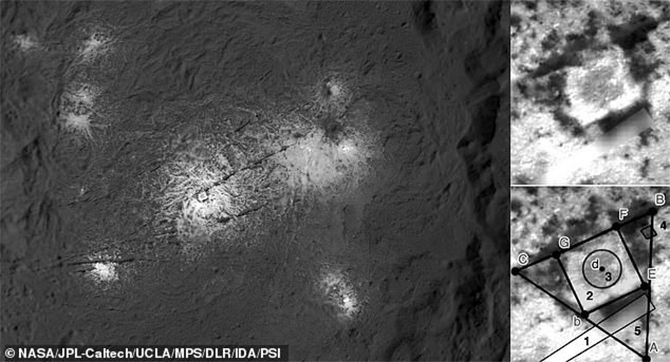Mysterious structure spotted by AI on the surface of dwarf planet

A Spanish team used an artificial intelligence (AI) system to search for extraterrestrial life where they interpreted the shape of a triangle outside a square of a crater on the dwarf planet Ceres from a NASA image.
The study published in Acta Astronautica suggested that scientists may need to think twice when using artificial intelligence to help in the search for extraterrestrial life.
163 volunteers with no training in astronomy were brought together by the researchers to describe what they saw on the image of the crater.
While the AI detected both a square and a triangle, the majority of humans only interpreted a square.
But once the triangle was pointed out to the humans, the amount of people who said they could see it rose from 7 per cent to 56 per cent.
This suggests the influence of AI could be strong on the human brain when interpreting alien characteristics on other planets, even when it’s questionable they even exist, Daily Mail UK reported.
The study’s author at the Spain’s University of Cadiz Gabriel G De la Torre said, ‘Both people and artificial intelligence detected a square structure in the images, but the AI also identified a triangle.”.
‘Despite being fashionable and having a multitude of applications, artificial intelligence could confuse us and tell us that it has detected impossible or false things.’

This compromises the usefulness of AI in the search for extra-terrestrial technosignatures – discernible evidence of advanced technology by alien civilisations, De la Torre said.
‘We must be careful with its implementation and use in the search for extraterrestrial intelligence.’
De la Torre and his team of neuropsychologists were observing one of the bright spots on the surface of Ceres, called Vinalia Faculae.
The image of the bright spot, which lies on a crater called Occator, was obtained by NASA’s Dawn spacecraft in 2018 at an altitude of about 36 miles.
Although the largest object in the main asteroid belt, Ceres is a dwarf planet, 587 miles in diameter, between the orbits of Mars and Jupiter.
The dwarf planet became famous in 2015 when bright spots were observed on Occator.
The mystery of the light source was solved when a NASA probe came close enough to discover that they originated from volcanic ice and salt emissions.
De la Torre said that what AI detected in Vinalia Faculae – both a triangle outside the square structure – is probably just a quirk of light and shadow.
The AI vision system had previously been trained with thousands of images of squares and triangles.
However, De la Torre did admit that AI could identify or interpret and extra-terrestrial features that go beyond human consciousness, ‘opening the doors to new realities for which we are not prepared’.
The experiment was a chance to explore how the search for technosignatures or space oddities might be influenced by our cognitive skills and consciousness.
The post Mysterious structure spotted by AI on the surface of dwarf planet appeared first on ARY NEWS.



Post A Comment
No comments :